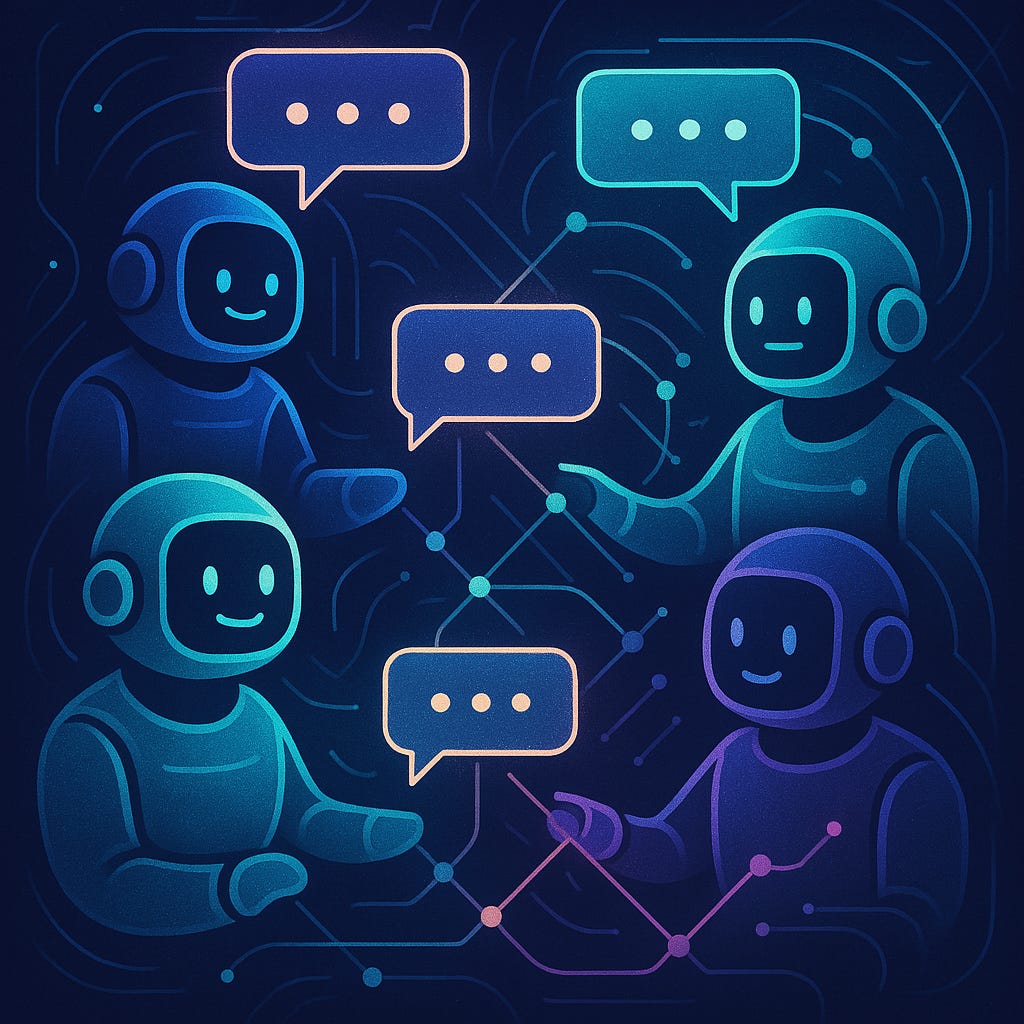Created Using GPT-4oNext Week in The Sequence:Our session about AI evals continues with reasoning benchmarks. The engineering sections dives into Google’s new A2A framework( again). Research discusses the amazing OLMO Trace and the opinion installment dives into another polemic topic.
You can subscribe to The Sequence below:TheSequence is a reader-supported publication. To receive new posts and support my work, consider becoming a free or paid subscriber.📝 Editorial: A2A is the New Hot Protocol in Agent LandIf 2025 is the year of agents, 2026 is going to be the year of multi-agent systems! For that to happen, agent interoperability needs to be solved.

Just like protocols like Anthropic’s Model Context Protocol(MCP) have accelerated the integration between agents and data now we need something similar for agent-to-agent communication. Last week, Google unveiled one of the most comprehensive efforts in this area. Google’s Agent2Agent (A2A) protocol introduces a standardized, open framework purpose-built for seamless inter-agent collaboration across heterogeneous environments.
A2A is engineered to enable secure, efficient, and extensible communication between autonomous agents, irrespective of vendor, architecture, or deployment context. This isn’t just about standardizing syntax—it’s about laying the groundwork for a dynamic, interoperable ecosystem where agents operate as composable primitives in enterprise-scale workflows. A2A's goal is to collapse the barriers between siloed systems, driving compound productivity and reducing coordination overhead in distributed AI environments.
Under the hood, A2A is designed with pragmatism and forward-compatibility in mind. It does not impose artificial constraints on how agents operate; rather, it embraces the innate modalities and lifecycles of agentic behavior, whether that means synchronous API calls or long-running asynchronous processes. By building atop ubiquitous protocols like HTTP, SSE, and JSON-RPC, A2A lowers the integration burden and ensures native compatibility with modern infrastructure stacks.
Security is deeply embedded in its architecture—enterprise-grade authentication and authorization mechanisms are built in, ensuring A2A can serve as a foundational layer in production systems. Moreover, the protocol is modality-agnostic, reflecting the reality that agents of the near future will operate across text, audio, video, and embedded UI components.A2A defines a clear interaction model: one agent (the "client") initiates a task, while another (the "remote") executes it.
This isn’t a simple request/response; it’s a rich, stateful conversation. Discovery is enabled through Agent Cards — JSON-based descriptors of agent capabilities, endpoints, and requirements. Once connected, agents exchange structured "parts" containing metadata-rich payloads, including contextual messages, artifacts, and user directives.
Tasks can be atomic or long-lived, producing real-time notifications or delayed artifacts. A key feature is user experience negotiation, allowing agents to dynamically agree on output formats—from markdown to live video—based on shared content types and supported renderers.What A2A really unlocks is a composable agent fabric.
Instead of building brittle pipelines with hard-coded API integrations, developers can now orchestrate task-specific agents like microservices—modular, discoverable, and dynamically connected. Imagine a recruiting workflow: a hiring manager’s agent identifies qualified candidates, passes that list to a scheduling agent, which in turn hands off the candidate profiles to a background check agent—all communicating natively, without glue code. This kind of frictionless interoperability isn’t just elegant—it’s operationally transformative, especially for enterprises managing dozens of bespoke AI tools across departments.
The protocol’s open-source release, backed by contributions from over 50 partners including Atlassian, Box, SAP, Salesforce, and LangChain, reflects a broader industry mandate: interoperability must be a shared standard, not a proprietary moat. Google has provided a full reference implementation, a living specification, and an invitation for open collaboration—recognizing that multi-agent AI is inherently a community-scale challenge. Early adopters have praised A2A for streamlining agent discovery, secure orchestration, and robust data exchange—early indicators that the protocol is more than theoretical promise.
🔎 AI ResearchThe AI Scientist-v2In the paper "The AI Scientist-v2: Workshop-Level Automated Scientific Discovery via Agentic Tree Search" researchers from Sakana AI, University of British Columbia, Vector Institute, and FLAIR, University of Oxford present an enhanced AI system capable of autonomous scientific discovery and manuscript generation. The AI Scientist-v2 introduces agentic tree search for experimentation, incorporates Vision-Language Models for feedback, and notably produced a fully AI-generated manuscript that was accepted by a peer-reviewed workshop.Better Reward ModelingIn the paper "Inference-Time Scaling for Generalist Reward Modeling" researchers from DeepSeek-AI and Tsinghua University investigate improving reward modeling (RM) with more inference compute for general queries and propose Self-Principled Critique Tuning (SPCT) for pointwise generative reward modeling (GRM) to foster scalable reward generation behaviors.
Their work demonstrates that SPCT significantly enhances the quality and scalability of GRMs, outperforming existing methods on various RM benchmarks and achieving better performance compared to training-time scaling.ADARFTIn the paper "Efficient Reinforcement Finetuning via Adaptive Curriculum Learnings" researchers from the LIME lab and the USC NLP group present ADARFT, an adaptive curriculum reinforcement finetuning method designed to improve the sample efficiency and reduce the computational cost of aligning large language models (LLMs) with task-specific goals. This approach dynamically selects training data based on the estimated difficulty of tasks, leading to more targeted learning and better performance compared to standard reinforcement finetuning.
Self-Steering LLMsIn the paper "Self-Steering Language Models" researchers from the Massachusetts Institute of Technology and Yale University introduce DISCIPL, a novel method for "self-steering" language models where a Planner model generates a task-specific inference program that is executed by a population of Follower models. This framework equips LMs with the ability to write recursive search procedures, enabling verifiable and efficient parallel inference that achieves competitive performance with much larger models on challenging constrained generation tasks.OLMOTRACEIn the paper "OLMOTRACE: Tracing Language Model Predictions to Their Training Data" researchers from the Allen Institute for AI, the University of Washington, Google, and Stanford University present OLMOTRACE, the first real-time system that traces the outputs of language models back to their full, multi-trillion-token training data by finding verbatim matches.
This publicly available and open-source tool helps users understand the behavior of language models through the lens of their training data, offering insights into fact checking, hallucination, and creativity.Debug-GymIn the paper "debug-gym: A Text-Based Environment for Interactive Debugging", Microsoft Research details the debug-gym framework, researchers introduce an interactive environment for debugging Python programs using language models. This work formally defines the interactive debugging problem and presents preliminary experimental results of LLM-based agents within this environment, highlighting the challenges they face when using interactive tools.
🤖 AI Tech ReleasesA2AGoogle open sourced the first version of the Agent2Agent protocol. ADKGoogle also introduced Agent Development Kit, an end-to-end framework for developing agentic applications. Cogito v1Deep Gogito, released a new family of fine-tuned Llama models with reasoning capabilities.
🛠 AI in ProductionBuilding AgentforceThe GM of the Salesforce AI platform shares some of lessons learned shipping Agentforce. 📡AI RadarStanford University published its anticipated AI Index Report. Thinking Machines, the AI startup founded by Mira Murati, is raising a massive $2 billion round.
Amazon CEO Andy Jassy included some very deep reflections about AI in its new letter to shareholders. Writer introduced AI HQ, a platform for agentic workflows in the enterprise. Amazon released Nova Sonic, a new voice foundation model with advanced understanding of human conversation.
Google introduced Ironwood, a new generation TPU optimized for inference. Rescale raised $115 million for its AI engineering platform.Canva released 6 new AI apps for its creative suite.
Incident.io raised $62 million for its suite of AI agents for IT incidents. TheSequence is a reader-supported publication.
To receive new posts and support my work, consider becoming a free or paid subscriber..
Technology

The Sequence Radar #531: A2A is the New Hot Protocol in Agent Land

Google just pushed the boundaries of multi agent communications















